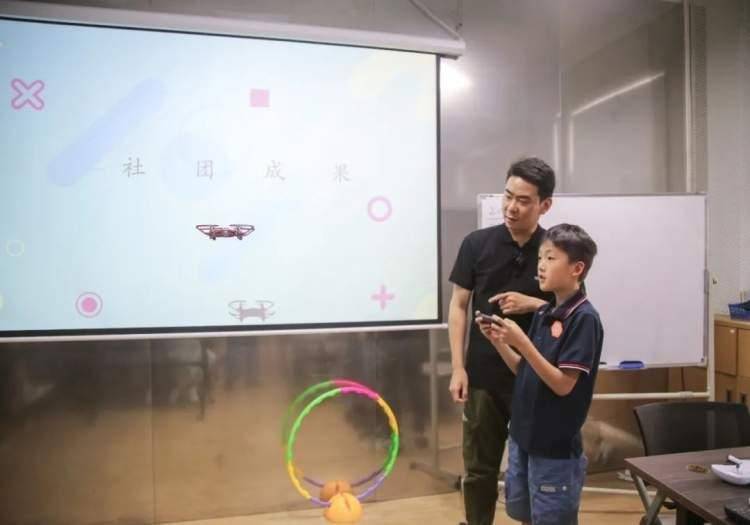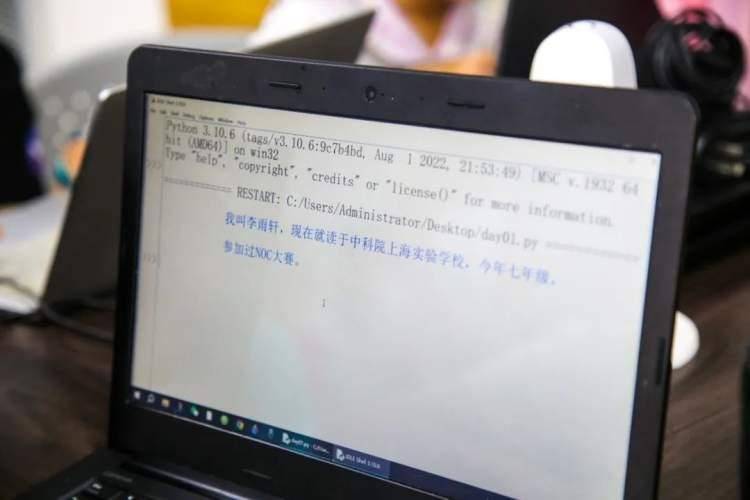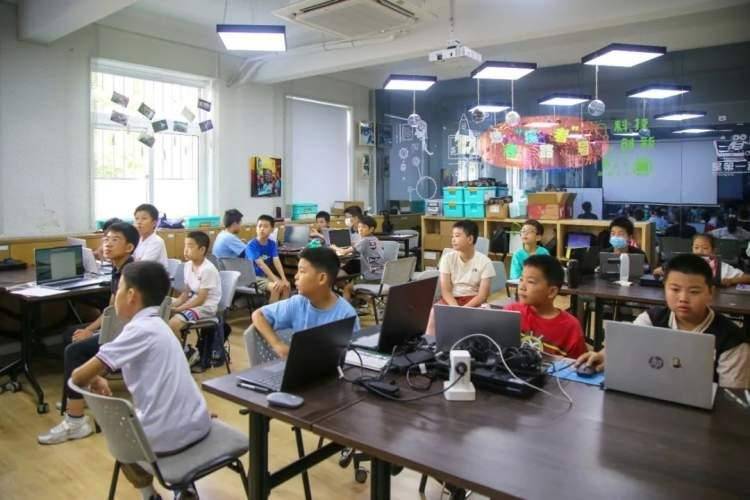 Technology peripherals
Technology peripherals
 AI
AI
 Aerospace, artificial intelligence, the science and technology innovation club at the entrance of 'Jia' has started classes!
Aerospace, artificial intelligence, the science and technology innovation club at the entrance of 'Jia' has started classes!
Aerospace, artificial intelligence, the science and technology innovation club at the entrance of 'Jia' has started classes!
Jiading Youth Science and Technology Innovation Center is the first open science and technology innovation space station in East China. It aims to provide various science and technology innovation courses and events for primary and secondary school students in the region to inspire their interest in science and technology innovation. Yesterday (September 9) was the first day of the new semester. A total of 108 newly recruited members participated in the on-site event. Let’s take a look!
Please count, how many propellers does the drone in my hand have? In the aerospace club, the teacher explained the control principles and basic operation methods of the drone while controlling it. The small drone hovered left and right in the sky, which aroused the interest of the students. Everyone carefully observed the model aircraft in their hands and were eager to try it. I thought it was really cool to see the teacher control the drone so skillfully. Now I want to master the knowledge of flying as soon as possible and try it myself! Student Lu Yijun said excitedly

Fifth grade student Zheng Ziqian has been an aviation fan since he was a child. When he learned that the club was recruiting new students during the summer vacation, he signed up without hesitation. "My dream is to be a captain, and I hope to get closer to my dream step by step through club study."
In the Artificial Intelligence Club, students are concentrating on learning the basic grammar of the Python language. A simple line of code must be continuously debugged and optimized to ensure correctness and efficiency. After student Li Yuxuan learned a new grammar sentence, he couldn't wait to apply it and introduced himself to his classmates in computer language.

The teachers at the distribution center are very professional. Through their guidance, I have made great progress in the modular design technology of mechanical controller hardware. Before entering the distribution center, Li Yuxuan already had a certain programming foundation. In the future, he hopes to have the opportunity to participate in various scientific and technological innovation competitions to further challenge himself
Fang Fei, director of the teaching and research department of Jiading District Youth Science and Technology Innovation Center, said that the club’s courses mainly cover the three fields of artificial intelligence, digital art and aerospace. The main goal of these courses is to cultivate students' scientific and technological innovation thinking and comprehensive abilities to enhance their scientific and technological innovation knowledge and skills

Since 2018, our club has been very popular every time it recruits new members. Fang Fei said: "We will comprehensively consider students' performance in language expression, knowledge structure, logical thinking, psychological quality and professional skills, etc., and select students with outstanding scientific and technological expertise. The actual number of participants is more than 100."
It is reported that as of August 2023, members of the distribution center community have participated in more than 70 domestic and foreign innovation competitions such as the 7th National Youth Drone Competition, the Soong Ching Ling Children's Invention Award, and the Shanghai Future Engineer Competition. Among them, more than 300 people have won the national competition, and more than 140 people have won the first prize in the municipal competition.
Source: Shanghai Jiading
The above is the detailed content of Aerospace, artificial intelligence, the science and technology innovation club at the entrance of 'Jia' has started classes!. For more information, please follow other related articles on the PHP Chinese website!

Hot AI Tools

Undresser.AI Undress
AI-powered app for creating realistic nude photos

AI Clothes Remover
Online AI tool for removing clothes from photos.

Undress AI Tool
Undress images for free

Clothoff.io
AI clothes remover

AI Hentai Generator
Generate AI Hentai for free.

Hot Article

Hot Tools

Notepad++7.3.1
Easy-to-use and free code editor

SublimeText3 Chinese version
Chinese version, very easy to use

Zend Studio 13.0.1
Powerful PHP integrated development environment

Dreamweaver CS6
Visual web development tools

SublimeText3 Mac version
God-level code editing software (SublimeText3)

Hot Topics
 1378
1378
 52
52
 How to configure Debian Apache log format
Apr 12, 2025 pm 11:30 PM
How to configure Debian Apache log format
Apr 12, 2025 pm 11:30 PM
This article describes how to customize Apache's log format on Debian systems. The following steps will guide you through the configuration process: Step 1: Access the Apache configuration file The main Apache configuration file of the Debian system is usually located in /etc/apache2/apache2.conf or /etc/apache2/httpd.conf. Open the configuration file with root permissions using the following command: sudonano/etc/apache2/apache2.conf or sudonano/etc/apache2/httpd.conf Step 2: Define custom log formats to find or
 How Tomcat logs help troubleshoot memory leaks
Apr 12, 2025 pm 11:42 PM
How Tomcat logs help troubleshoot memory leaks
Apr 12, 2025 pm 11:42 PM
Tomcat logs are the key to diagnosing memory leak problems. By analyzing Tomcat logs, you can gain insight into memory usage and garbage collection (GC) behavior, effectively locate and resolve memory leaks. Here is how to troubleshoot memory leaks using Tomcat logs: 1. GC log analysis First, enable detailed GC logging. Add the following JVM options to the Tomcat startup parameters: -XX: PrintGCDetails-XX: PrintGCDateStamps-Xloggc:gc.log These parameters will generate a detailed GC log (gc.log), including information such as GC type, recycling object size and time. Analysis gc.log
 How to implement file sorting by debian readdir
Apr 13, 2025 am 09:06 AM
How to implement file sorting by debian readdir
Apr 13, 2025 am 09:06 AM
In Debian systems, the readdir function is used to read directory contents, but the order in which it returns is not predefined. To sort files in a directory, you need to read all files first, and then sort them using the qsort function. The following code demonstrates how to sort directory files using readdir and qsort in Debian system: #include#include#include#include#include//Custom comparison function, used for qsortintcompare(constvoid*a,constvoid*b){returnstrcmp(*(
 How to optimize the performance of debian readdir
Apr 13, 2025 am 08:48 AM
How to optimize the performance of debian readdir
Apr 13, 2025 am 08:48 AM
In Debian systems, readdir system calls are used to read directory contents. If its performance is not good, try the following optimization strategy: Simplify the number of directory files: Split large directories into multiple small directories as much as possible, reducing the number of items processed per readdir call. Enable directory content caching: build a cache mechanism, update the cache regularly or when directory content changes, and reduce frequent calls to readdir. Memory caches (such as Memcached or Redis) or local caches (such as files or databases) can be considered. Adopt efficient data structure: If you implement directory traversal by yourself, select more efficient data structures (such as hash tables instead of linear search) to store and access directory information
 How to configure firewall rules for Debian syslog
Apr 13, 2025 am 06:51 AM
How to configure firewall rules for Debian syslog
Apr 13, 2025 am 06:51 AM
This article describes how to configure firewall rules using iptables or ufw in Debian systems and use Syslog to record firewall activities. Method 1: Use iptablesiptables is a powerful command line firewall tool in Debian system. View existing rules: Use the following command to view the current iptables rules: sudoiptables-L-n-v allows specific IP access: For example, allow IP address 192.168.1.100 to access port 80: sudoiptables-AINPUT-ptcp--dport80-s192.16
 How debian readdir integrates with other tools
Apr 13, 2025 am 09:42 AM
How debian readdir integrates with other tools
Apr 13, 2025 am 09:42 AM
The readdir function in the Debian system is a system call used to read directory contents and is often used in C programming. This article will explain how to integrate readdir with other tools to enhance its functionality. Method 1: Combining C language program and pipeline First, write a C program to call the readdir function and output the result: #include#include#include#includeintmain(intargc,char*argv[]){DIR*dir;structdirent*entry;if(argc!=2){
 How to learn Debian syslog
Apr 13, 2025 am 11:51 AM
How to learn Debian syslog
Apr 13, 2025 am 11:51 AM
This guide will guide you to learn how to use Syslog in Debian systems. Syslog is a key service in Linux systems for logging system and application log messages. It helps administrators monitor and analyze system activity to quickly identify and resolve problems. 1. Basic knowledge of Syslog The core functions of Syslog include: centrally collecting and managing log messages; supporting multiple log output formats and target locations (such as files or networks); providing real-time log viewing and filtering functions. 2. Install and configure Syslog (using Rsyslog) The Debian system uses Rsyslog by default. You can install it with the following command: sudoaptupdatesud
 Where is the Debian Nginx log path
Apr 12, 2025 pm 11:33 PM
Where is the Debian Nginx log path
Apr 12, 2025 pm 11:33 PM
In the Debian system, the default storage locations of Nginx's access log and error log are as follows: Access log (accesslog):/var/log/nginx/access.log Error log (errorlog):/var/log/nginx/error.log The above path is the default configuration of standard DebianNginx installation. If you have modified the log file storage location during the installation process, please check your Nginx configuration file (usually located in /etc/nginx/nginx.conf or /etc/nginx/sites-available/ directory). In the configuration file



